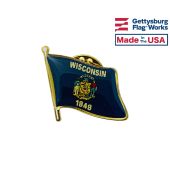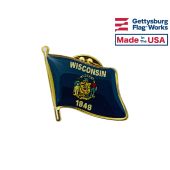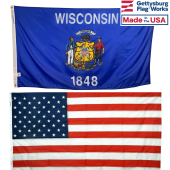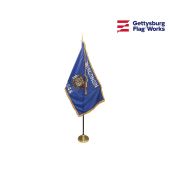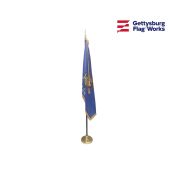Wisconsin State Flag
- Wisconsin & Battle-Tough® American Flag Combo PackStarting at $69.95
-
-
-
Wisconsin State Flag
The design of the Wisconsin state flag is similar to that of many other state flags, but the details of the design are enough to ensure that it can be distinguished from the others. The flag of Wisconsin has had the honor of being flown over Antarctica, a fact which has ensured that the flag's history stands out from that of the other state flags of the United States.
Colors and Symbolism of the Flag of Wisconsin
The Wisconsin state flag has a dark blue field that displays the coat of arms of Wisconsin in the center, with the state's name above it and the year that it joined the Union below it. The coat of arms is a yellow shield that is crowned by a badger and supported by both a sailor and a miner. The shield is divided into four equal sections that display a plow, a pick and shovel, an anchor, and an arm holding a hammer. A cornucopia and a set of thirteen lead ingots are placed below the shield, and the state's motto is placed above it.
Each piece of the coat of arms represents a different aspect of Wisconsin. The badger is the state's animal, while the sailor and miner represent those who work at sea and on land. The plow represents the state's agricultural workers, the pick and shovel represent its mining industry, the anchor stands for navigation, and the arm and hammer represent industry. The cornucopia is a symbol of prosperity, while the lead ingots represent both the state's mineral resources and the thirteen states that founded the United States of America.
History of the Wisconsin State Flag
The first flag of Wyoming was designed in 1866 so that the state's soldiers could have their own symbol, but it was not adopted for use as a state flag until significantly later. The government of Wyoming adopted it for civilian use in 1913. It used a different version of the state's coat of arms and did not include the state's name or year of admission into the Union, but it otherwise resembled the current flag. The text was added to the flag in 1981 in order to make the design more distinct from the other flags in America, which created the flag of Wisconsin that is still in use today.
A short history of the Wisconsin State flag
The original Wisconsin state flag was very similar to this one used today. The seal has stayed the same, but in 1979 the name and year were added to set this flag apart from the many state flags containing just a shield on a blue background.The arms and the seal were designed in 1851 by Governor Nelson Dewey and the Chief Justice Edward Ryan. On each side of the seal is a sailor and a miner. A badger is on top of the shield, representing the early miners. The flag was adopted in February 1911, The center of the shield has a belt containing the arms of the USA together with the national motto "forward". In 1980 new legislation added the name of the state at the top and the date of admission to the union below the coat of arms.
A short history of Wisconsin (Badger State)
It was first settled by the french and part of New France until 1783 when it was ceded to Britain. In 1783 Britain conceded it to the USA and it was part of the North-West Territory until 1836, when it became the Territory of Wisconsin which was admitted to the union on May 29, 1848.The united states gained these lands as a part of the Treaty of Ghent, which officially ended the War of 1812.
Became a State: May 29, 1848
Capital: Madison
Current Flag Adopted: 1980
State Motto: Forward
